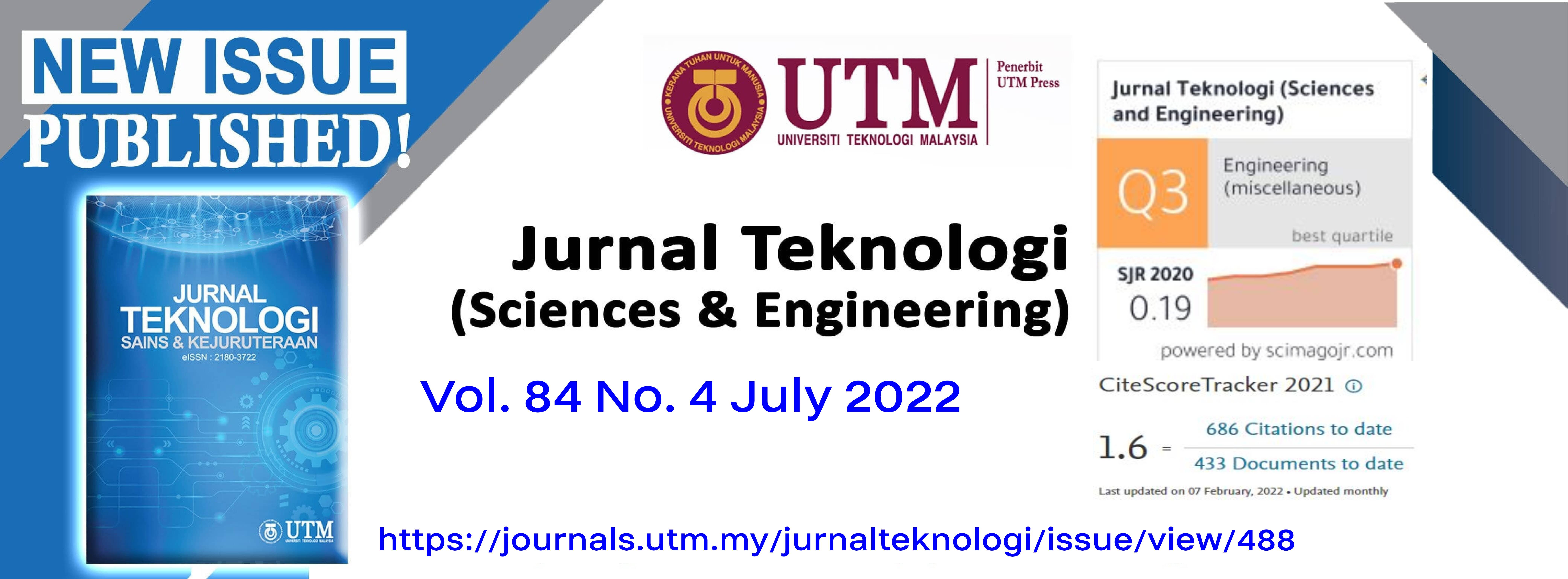PROPERTIES OF CONCRETE UTILIZING SELF-CEMENTING HIGH-CALCIUM FLY ASH AS SOLE BINDER MATERIAL
DOI:
https://doi.org/10.11113/jurnalteknologi.v84.17973Keywords:
High-calcium fly ash, self-cementing, very low water-to-cementitious ratio, workability, slump loss, compressive strengthAbstract
Fly ash, a waste material derived from the coal burning in power plants, could be utilized in concrete mixtures as a filler or as a cement replacement material, either partially or fully. Some papers also report that high-calcium fly ash can be utilized as a cementitious material through the hydration process. However, there are just a few papers that studied the behavior of concrete that utilizes high-calcium fly ash as the sole binder material without any chemical activators. Furthermore, there are no reports about whether the effect of the different water-to-cementitious ratios of this concrete is the same as the ordinary Portland cement concrete. This paper presents an initial development on the use of fly ash as a sole binder material, i.e., 100% fly ash concrete without any chemical solution as an activator. This research utilizes the high calcium content in the fly ash to produce concrete with a commonly used method (just add the water without any alkali activator) and investigates how the water-to-cementitious ratio can influence the compressive strength of the paste and the concrete as well. The calcium content in the fly ash used in this study was in the range of 19–22 percent of the total weight of fly ash. Paste compressive strength of 66.78 MPa was obtained at 28 days with a very low water-to-cementitious ratio of 0.110.
References
Miller, S. A., Horvath, A., and Monteiro, P. J. M. 2016. Readily Implementable Techniques Can Cut Annual CO2 Emissions from the Production of Concrete by Over 20%. Environmental Research Letters. 11(7).
DOI: http://dx.doi.org/10.1088/1748-9326/11/7/074029.
World Coal Association. 2020. Coal Combustion Products.
http://worldcoal.org/coal/uses-coal/coal-combustion-products.
Kutchko, B. G. and Kim, A. G. 2006. Fly Ash Characterization by SEM-EDS. FUEL. 85(17-18): 2537-2544.
DOI: http://dx.doi.org/10.1016/j.fuel.2006.05.016.
ASTM C618-19. 2019. Standard Specification for Coal Fly Ash and Raw or Calcined Natural Pozzolona for Use in Concrete. American Society for Testing and Materials. West Conshohocken, PA, USA.
DOI: http://dx.doi.org/10.1520/C0618-19.
CAN/CSA-A3001-13. 2013. Cementitious Materials for Use in Concrete. Canadian Standards Association. Toronto, Ontario, Canada.
Shaikh, F., Kerai, S., and Kerai, S. 2015. Effect of Micro-silica on Mechanical and Durability Properties of High Volume Fly Ash Recycled Aggregate Concretes (HVFA-RAC). Advances in Concrete Construction. 3(4): 317-331F
DOI: http://dx.doi.org/10.12989/acc.2015.3.4.317.
Sunil, B. M., Manjunatha, L. S., Ravi, L., and Yaragal, S. C. 2015. Potential Use of Mine Tailings and Fly Ash in Concrete. Advances in Concrete Construction. 3(1): 55-69B.
DOI: http://dx.doi.org/10.12989/acc.2015.3.1.055.
Zhang, W., Zhang, Y., and Gao, L. 2019. Effect of Low-calcium Fly Ash on Sulfate Resistance of Cement Paste Under Different Exposure Conditions. Advances in Concrete Construction. 7(3): 175-181W.
DOI: http://doi.org/10.12989/acc.2019.7.3.175.
Antoni, A. Widianto, K., Wiranegara, J. L., and Hardjito, D. 2017. Consistency of Fly Ash Quality for Making High Volume Fly Ash Concrete. Jurnal Teknologi. 79(7-2): 13-20. DOI: https://doi.org/10.11113/jt.v79.11870.
Antoni A., Wattimena, O. K., and Hardjito, D. 2013. Improving Surface Durability of High Volume Fly Ash Concrete with Application of Alkali Solution. Advanced Materials Research. 626: 636-640.
DOI:http://dx.doi.org/10.4028/www.scientific.net/AMR.626.636
Bentz, D. P. 2010. Powder Additions to Mitigate Retardation in High-volume Fly Ash Mixtures. ACI Materials Journal. 107(5): 508-514.
DOI: http://dx.doi.org/10.14359/51663971.
Crouch, L., Hewitt, R., and Byard, B. 2007. High Volume Flies Ash Concrete. World of Coal Ash Conference (WOCA). Northern Kentucky, USA, May 2007.
Donatello, S., Fernández-Jimenez, A., and Palomo, A. 2013. Very High Volume Fly Ash Cements. Early Age Hydration Study using Na2SO4 as an Activator. Journal of the American Ceramic Society. 96(3): 900-906.
DOI: http://dx.doi.org/10.1111/jace.12178.S.
Huang, C. H., Lin, S. K., Chang, C. S., and Chen, H. J. 2013. Mix Proportions and Mechanical Properties of Concrete Containing Very High-volume of Class F Fly Ash. Construction and Building Materials. 46: 71-78.
DOI:http://dx.doi.org/10.1016/j.conbuildmat.2013.04.016.C
Gupta, S. and Chaudhary, S. 2020. Use of Fly Ash for the Development of Sustainable Construction Materials. New Materials in Civil Engineering. Netherlands: Elsevier. DOI:http://dx.doi.org/10.1016/B978-0-12-818961-0.00021-1
Topark-ngarm, P., Chindaprasirt, P., and Sata, V. 2014. Setting Time, Strength, and Bond of High-calcium Fly Ash Geopolymer Concrete. The Journal of Materials in Civil Engineering. 27(7): 1-7.
DOI:http://dx.doi.org/10.1061/(ASCE)MT.1943-5533.0001157
Goriparthi, M. R. and Gunneswara Rao, T. D. 2017. Effect of Fly Ash and GGBS Combination on Mechanical and Durability Properties of GPC. Advances in Concrete Construction. 5(4): 313-330.
DOI: http://dx.doi.org/10.12989/acc.2017.5.4.313.
Jindal, B. B., Singhal, D., Sharma, S. K., Ashish, D. K., and Parveen. 2017. Improving Compressive Strength Of Low Calcium Fly Ash Geopolymer Concrete with Alccofine. Advances in Concrete Construction. 5(1): 17-29.
DOI: http://dx.doi.org/10.12989/acc.2017.5.1.17.
Davidovits, J. 2015. Geopolymer Chemistry & Application. 4th Edition. France: Institut Geopolymere.
Provis, J. L. 2018. Alkali-activated Materials. Cement and Concrete Research. 114: 40-48.
DOI: http://dx.doi.org/10.1016/j.cemconres.2017.02.009.
Wattimena, O. K., Antoni A., and Hardjito, D. 2017. A Review on the Effect of Fly Ash Characteristics and their Variations on the Synthesis of Fly Ash Based Geopolymer. AIP Conference Proceedings Volume 1887. Malang, East Java, Indonesia, August 2017.
DOI: http://dx.doi.org/10.1063/1.5003524.
Hardjito, D., Cheak, C. C., and Lee Ing, C. H. 2008. Strength and Setting Times Of Low Calcium Fly Ash-based Geopolymer Mortar. Modern Applied Science. 2(4): 3-11. DOI: http://dx.doi.org/10.5539/mas.v2n4p3.
Thomas, M. D. A. 2007. Optimizing the Use of Fly Ash in Concrete. Portland Cement Association. Skokie, Illinois, USA.
DOI: http://dx.doi.org/10.15680/IJIRSET.2015.0409047.
Berry, M., Cross, D., and Stephens, J. 2009. Changing the Environment: An Alternative "Green" Concrete Produced without Portland Cement. World of Coal Ash Conference (WOCA), Lexington, KY, USA, May 2009.
Cross, D., Stephens, J., and Vollmer, J. 2005. Structural Applications of 100 Percent Fly Ash Concrete. World of Coal Ash Conference (WOCA). Lexington, KY, USA, April 2005.
Roskos, C., Cross, D., Berry, M., and Stephens, J. 2011. Identification and Verification of Self-cementing Fly Ash Binders for "Green" Concrete. World of Coal Ash Conference (WOCA). Denver, CO, USA, May 2011.
Downloads
Published
Issue
Section
License
Copyright of articles that appear in Jurnal Teknologi belongs exclusively to Penerbit Universiti Teknologi Malaysia (Penerbit UTM Press). This copyright covers the rights to reproduce the article, including reprints, electronic reproductions, or any other reproductions of similar nature.
















